Inside the Nanosat Lab
Tiny satellites, big ambitions.
/https://tf-cmsv2-smithsonianmag-media.s3.amazonaws.com/filer/78/76/78763007-e70d-4c6e-98ca-99ff70f342d4/01d_am2017_ubeseniorpostersonionstudio_live.jpg)
The Nanosat Lab at the State University of New York at Buffalo is thrumming like a beehive. More than 100 excited, exhausted undergraduates are very hard at work on a volunteer project: building three tiny satellites. The students are nervously anticipating the arrival of their customers—the U.S. Air Force and NASA—whose reviewers will judge their progress and the quality of their work.
One of the satellites—the Glint Analyzing Data Observation Satellite, or GLADOS—is about to undergo what’s called a pre-integration review. “It’s kind of our pass/fail,” says junior Maura Sutherland, the lab’s chief of public relations. If the students pass, the satellite will move one step closer to launch. If not, well, pass/fail offers only one other option.
The pressure is intense, but Maura and her colleagues love the lab. They show up there even during UB’s winter and summer breaks. Maura’s roommate, Rachel Suitor (also a junior and the chief engineer for the Spectrometry Observation for Reflectivity Analysis—SORA—satellite), says, “The lab is definitely more exciting than class.”
Two of the satellites are being built for the Air Force as part of its University Nanosat Program—a competitive program for colleges and universities around the country. To qualify for grants from the program, John Crassidis, a professor in the mechanical and aerospace engineering department, started the lab and proposed the first project: a satellite to research space junk. Information about orbiting pieces of dead spacecraft can help avoid collisions between them and functioning satellites and spacecraft.
NASA estimates that 20,000 pieces of debris larger than a softball share low Earth orbit with more than 1,000 expensive, functioning satellites and the International Space Station. One technique NASA and the Air Force use to gather information about space junk is to measure light reflecting off the orbiting debris.
That’s the idea behind two of the lab’s satellites. Measuring light, the nanosats will help determine the sizes, shapes, spins, and paths of the pieces of space junk. The team working on GLADOS, a briefcase-size satellite that will use cameras to capture visible and infrared light, was awarded two $110,000 grants from the Air Force University Nanosat Program. SORA, which won a single $110,000 grant, will use a spectrometer to analyze diffuse, reflected light. The UB lab’s third and newest project is being built for NASA’s Undergraduate Student Instrument Project. Called LinkSat, it will measure radio waves, mostly emitted from ground-based devices, in order to characterize the noise environment in low Earth orbit.
One might suppose that such a sophisticated, high-stakes program would allow only elite engineering students to participate. But the lab will take any student; the only requirement is U.S. citizenship. “If you’re willing to work, we’ll find something for you to do,” says Crassidis. Each satellite team is headed by a professor who acts as the principal investigator and is ultimately responsible for the project. But all the actual work is done by the students.
Seamus Lombardo is the program manager for GLADOS. “I take care of scheduling, task management,” he says. “I have to be aware of what’s going on technically so I can schedule it, and ask the pertinent questions. I also do all the budgeting.” Rachel, as chief engineer for SORA, says her job is more on the technical side: “I make sure everything gets designed properly and stays true to our requirements.”

“There’s a lot of unique challenges that come both with space and also with being a low-budget undergraduate program,” says Seamus. Everything on board needs to be able to survive a rocket’s violent shaking on liftoff and the extreme temperature changes that a satellite endures as it goes from night to day during every 90-minute orbit. Rachel and her team labored last summer to make sure an off-the-shelf spectrometer’s interior components won’t pull apart on liftoff. A lens they selected crowded out the attitude and termination systems. “There’s been a lot of tradeoffs,” she says, “but we finally came to a solution.”
Interest in the project has spread throughout the UB community, says Maura. “People come up to us and ask if they can join. We started setting up Saturday workshops. For example, our software lead would take all of the software students and walk them through various exercises.”
Part of the appeal: “It’s a very real application,” says Seamus. “The Air Force will actually use this satellite. Dr. Crassidis will use and analyze the data. Our budget is $220,000—it’s not a light responsibility for someone who joined the program three years ago as a freshman.”
“They [Air Force reviewers] do not take it easy on them just because they’re students,” says Crassidis. “They treat them like real engineers.” But he takes a mostly hands-off approach. “I’ll notice things that I know will get caught in a critique, but I’ll let them take that hit. I want them to have the experience of what happens in the real world.” For many of the students, the lab experience is already paying off. Maura and Seamus have both interned at SpaceX.
In early February, the Air Force reviewers arrived. The review of GLADOS took almost 10 hours, and the questions were tough. Finally the students got the news. “They had some changes they’d like to see,” says Seamus, “but we’re moving onto the next phase” to deliver GLADOS for launch.
